Wall Pressure and Shear Stress Spectra from Direct Numerical ...
Wall Pressure and Shear Stress Spectra from Direct Numerical ...
Wall Pressure and Shear Stress Spectra from Direct Numerical ...
Create successful ePaper yourself
Turn your PDF publications into a flip-book with our unique Google optimized e-Paper software.
2 HU, MORFEY, AND SANDHAM<br />
@u i<br />
@t<br />
ijku j! k 1i<br />
@<br />
@x i<br />
1<br />
Re<br />
@ 2 u i<br />
@x j@x j<br />
where the Reynolds number is Re u h = , with being the<br />
kinematic viscosity. p uiui=2 is the modified pressure, ijk is<br />
the permutation tensor, <strong>and</strong> ! k ijk@uj=@xi is the vorticity.<br />
Poiseuille flow is driven by a mean pressure gradient, whose<br />
nondimensional value is equal to 1. The channel coordinates are<br />
x1 x in the streamwise direction, x2 y in the spanwise direction,<br />
<strong>and</strong> x 3<br />
(2)<br />
z in the wall-normal direction, with the channel walls at<br />
z 1. u; v; w denote the nondimensional velocities in the<br />
x; y; z directions.<br />
The spectral method of Kleiser <strong>and</strong> Schumann [17] has been used<br />
to solve the incompressible governing equations with Fourier<br />
discretization applied to the two periodic directions x; y , <strong>and</strong><br />
Chebyshev polynomial expansion to the wall-normal direction z.In<br />
the periodic directions a twofold discrete Fourier transformation is<br />
carried out for any quantity q by the following forward <strong>and</strong> backward<br />
transforms:<br />
~q k xl;k ym<br />
1<br />
XN y 1<br />
Ny j 0<br />
exp ik ymy j<br />
q x i;y j ~q 0;y j 2 XN x=2<br />
1<br />
XN x 1<br />
Nx i 0<br />
l 1<br />
XN y=2<br />
m N y=2<br />
q x i;y j exp ik xlx i<br />
~q k xl;k ym exp ik ymy j<br />
exp ikxlxi (4)<br />
p<br />
where i 1.<br />
kxl 2 l=Lx 0 l Nx=2 <strong>and</strong> kym 2 m=<br />
Ly Ny=2 m Ny=2 are wave numbers in the x <strong>and</strong> y<br />
directions, respectively. The grid coordinates are uniform in the<br />
streamwise <strong>and</strong> spanwise directions with xi iLx=Nx 0 i Nx <strong>and</strong> yj jLy=Ny 0 j Ny , <strong>and</strong> are stretched in the wall-normal<br />
Q1 direction with zk cos k= Nz 1 0 k Nz 1 .(Nx Ny Nz) grid points are used in the computational box of size Lx Ly 2.<br />
Time advance is achieved with a third-order Runge–Kutta method<br />
for the convective term <strong>and</strong> the Crank–Nicolson method for the<br />
pressure <strong>and</strong> viscous terms. An implicit treatment is employed to<br />
avoid extremely small time steps in the near wall region resulting<br />
<strong>from</strong> the Chebyshev discretization. De-aliasing via the “3=2 rule” has<br />
been applied to the nonlinear convective term. More details on the<br />
method can be found in [14,15,18,19].<br />
B. DNS Cases <strong>and</strong> Results<br />
Simulations have been carried out for turbulent channel flow at a<br />
series of Reynolds numbers up to Re 1440. Large boxes have<br />
been used for each case to include the large scale structures in the<br />
computational domain. This is checked by making sure that the twopoint<br />
correlation functions for velocity <strong>and</strong> pressure drop to zero at<br />
large separation [14,15]. In the x <strong>and</strong> y directions, resolutions are<br />
kept the same in wall units for all calculations, at x 16:88 <strong>and</strong><br />
y 8:44 (the Re 130 case has slightly lower values); these<br />
values are comparable to those used by KMM [9]. In the wall-normal<br />
direction more than 10 points are located in the near wall region<br />
(3)<br />
z < 9, with the first point 0.12 to 0.03 wall units <strong>from</strong> the wall. The<br />
grid spacing at the channel centerline increases <strong>from</strong> 4.71 wall units<br />
for Re 90 to 9.42 for Re 1440. For higher Reynolds number<br />
cases, it is comparable to y but still lower than x .<br />
Computational parameters for each case are given in Table 1.<br />
The initial flowfield used to start the simulation consisted of a base<br />
mean flow calculated <strong>from</strong> the log law, with sinusoidal velocity<br />
perturbations added. It was marched sufficiently far in time until the<br />
flow became fully developed, before any statistics were collected.<br />
This was monitored by comparing statistics <strong>from</strong> successive time<br />
segments; data <strong>from</strong> earlier segments were discarded if they showed<br />
a trend. Whenever an existing flowfield was available <strong>from</strong> either a<br />
coarse grid simulation or another (lower) Reynolds number case, it<br />
was interpolated in wave space to speed up the initial flow<br />
development.<br />
After the flow had reached a statistically stable state, single-point<br />
<strong>and</strong> two-point statistics were collected for velocity, pressure, <strong>and</strong><br />
their derivatives, including velocity moments up to fourth order.<br />
Details of quantities collected are given in Hu <strong>and</strong> S<strong>and</strong>ham [20].<br />
Samples of the statistics are available at http://www.dnsdata.afm.ses.<br />
soton.ac.uk/. Data have been compared with KMM [9] <strong>and</strong> MKM<br />
[10], good agreement being found [14,15] for the corresponding (or<br />
nearest) Reynolds number case. Some mean flow quantities are given<br />
in Table 1. Umax <strong>and</strong> Um are the channel centerline <strong>and</strong> mean<br />
velocity, respectively. 1 <strong>and</strong> are the boundary-layer displacement<br />
<strong>and</strong> momentum thickness on the channel walls. The calculated<br />
Reynolds number, based on friction velocity results calculated <strong>from</strong><br />
mean velocity statistics, is close to the nominal value given for each<br />
simulation; the largest discrepancy (for the Re 1440 case) is<br />
0.78%, which is an indication of the quality of the statistics.<br />
From measurements of Poiseuille flow in a high aspect ratio duct,<br />
Dean [21] concluded that the difference between centerline velocity<br />
<strong>and</strong> mean velocity ( U max<br />
U m =u ) in plane Poiseuille flow<br />
decreases with Reynolds number <strong>and</strong> tends to a constant value 2.64<br />
for high Reynolds number (Re m 2h U m= > 10 5 ). This quantity<br />
ranges <strong>from</strong> 2.52 to 3.05 for the current calculations, with the lowest<br />
Reynolds number case (Re m 2:57 10 3 ) having the highest value<br />
of 3.05; the others vary between 2.52 <strong>and</strong> 2.71 <strong>and</strong> show no clear<br />
trend with Reynolds number. The ratio U max=U m for the current<br />
simulations matches Dean’s empirical formula U max=<br />
Um 1:28Re 0:0116<br />
m to within 0.4% for Re<br />
is 1% for Re 130 <strong>and</strong> 4% for Re 90.<br />
180; the difference<br />
Mean velocity profiles for each of the different Reynolds number<br />
cases are shown in Fig. 1. Viscous scaling is used for Fig. 1a, with<br />
velocity u u =u plotted against distance <strong>from</strong> the wall in wall<br />
units, z h jz j u = . Velocity profiles collapse in the near<br />
wall region. Away <strong>from</strong> the wall, the three low Reynolds number<br />
cases (Re 180, 130, 90) are influenced by the low Reynolds<br />
number effect noted in MKM [10], but the two cases with Re 360<br />
<strong>and</strong> 720 collapse up to z 100. Outer scaling is used for Fig. 1b,<br />
where the mean velocity normalized by the channel centerline<br />
velocity, u=Umax, is plotted against distance <strong>from</strong> the wall,<br />
zw 1 jzj. The collapsed region extends further towards the wall<br />
for higher Reynolds numbers, with the two highest Reynolds number<br />
cases showing collapse down to z w<br />
Table 1 Parameters <strong>and</strong> mean flow properties for each simulation<br />
0:1.<br />
Figure 2 shows profiles of the rms velocities. There is a general<br />
trend for all three components to increase as the Reynolds number<br />
increases. The maximum streamwise rms velocity appears at z<br />
15 for all Reynolds numbers. Changes in this maximum value with<br />
Re Re Box size Grid points<br />
Nom. Calc. (Lx Ly Lz) (NxNyNz) Umax Um 1 102 1440 1451.3 12 6 2 1024 1024 481 23.83 21.12 0.1135 8.557<br />
720 716.5 12 6 2 512 512 321 21.52 18.93 0.1198 8.713<br />
360 361.8 12 6 2 256 256 161 19.94 17.40 0.1273 8.720<br />
180 180.2 24 12 2 256 256 121 18.20 15.66 0.1400 8.621<br />
130 130.0 24 12 2 196 196 81 17.65 15.01 0.1496 8.646<br />
90 90.0 48 24 2 256 256 61 17.29 14.25 0.1763 9.152
















